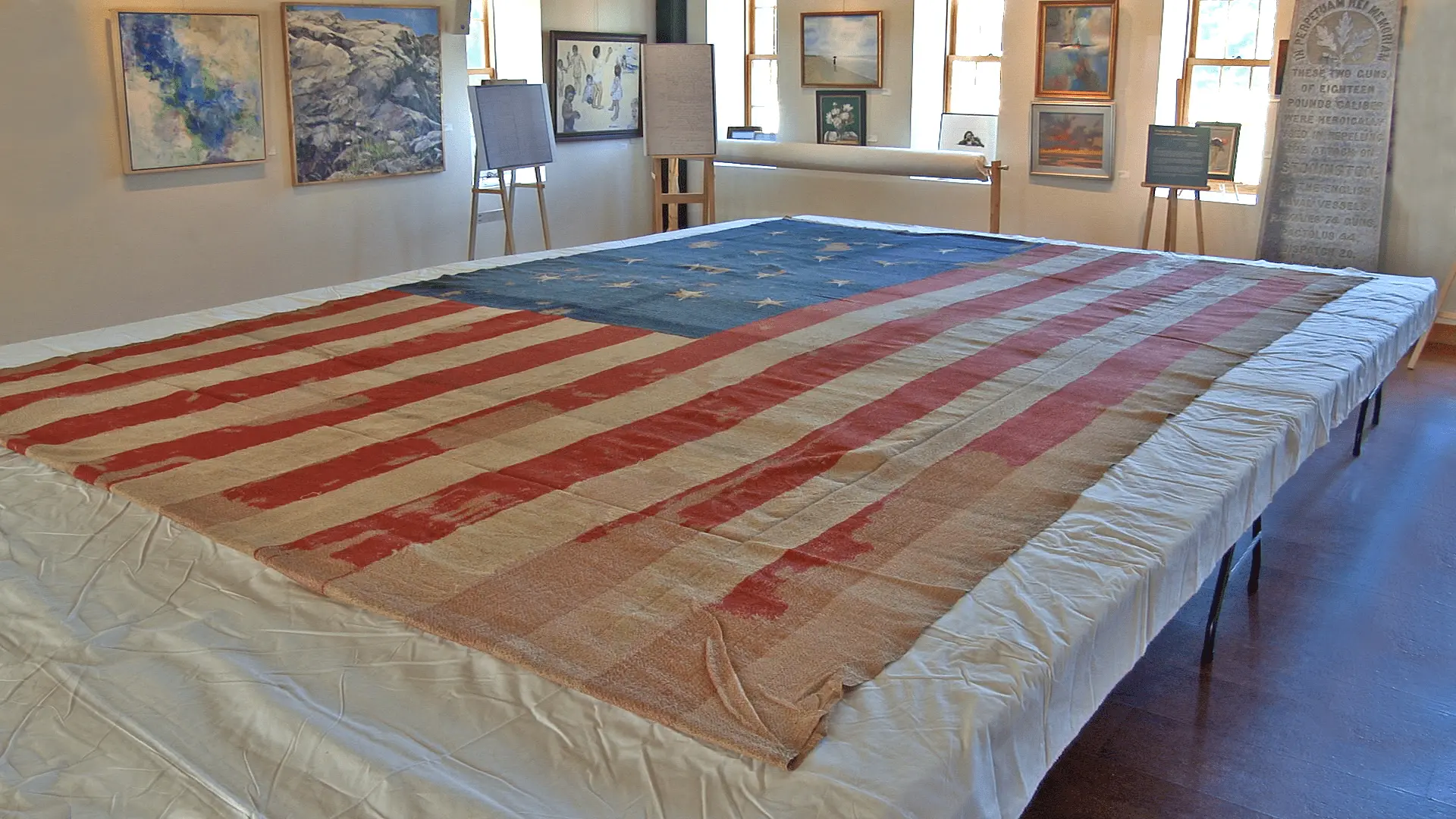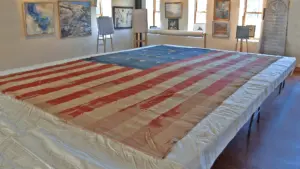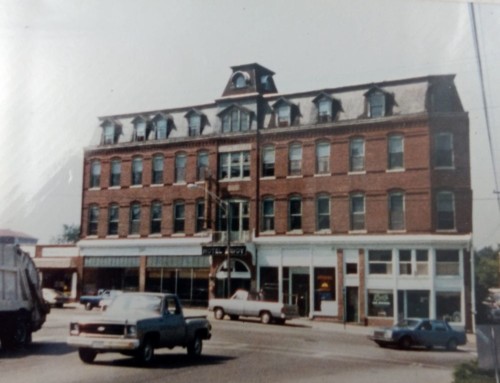During the Battle of Stonington in the War of 1812, a 16-star flag flew defiantly over the small Grasshopper Fort defending Stonington from a British naval squadron. This battle flag is the only 16-star American flag to ever fly over an American victory and is sometimes called the Star Spangled Banner’s little sister. This is the story of the two flags and how, in many ways, they are similar.
Late in the War of 1812, a large British naval squadron attacked the small New England town of Stonington. On the second day of the attack, the British warship Dispatch loosed a powerful broadside against Stonington’s small earthen Grasshopper Fort. Shells from the Dispatch’s guns blasted the 16-star flag from its pole and it fluttered to the ground. Dirt from the sides of the fort exploded as British shells struck the around the fort. A small group of defenders, possibly twenty in number, fought until they ran out of gunpowder.
Forced to retreat the men rescued their downed flag and spiked the cannon, rendering it inoperable. The men, their eyes burning and faces blackened, retreated amidst the taunts of the British Navy. One fellow suggested they take the flag with them to preserve it from British capture. Jeremiah Holmes, who was leading the American gun crews, objected. “No, that flag don’t come down while I’m alive,” he shouted. Grabbing the hammer and nails he’d used to spike the cannon he hoisted Dean Gallup onto his shoulders. The two men stood nailing the flag to the pole as shrapnel flew all around them.
This dramatic scene and subsequent American victory in the Battle of Stonington has been celebrated in the town for more than 200 years. For major anniversaries of the battle, Stonington’s 16-Star Banner is taken out of storage and put on display. Over time the flag became so frail it had to be restored to help preserve it. The flag is now maintained by the Stonington Historical Society at the Woolworth Library and Research Center.
Oh, say can you see by the dawn’s early light
What so proudly we hailed at the twilight’s last gleaming?
Whose broad stripes and bright stars through the perilous fight,
O’er the ramparts we watched were so gallantly streaming?
And the rocket’s red glare, the bombs bursting in air,
Gave proof through the night that our flag was still there.
Oh, say does that Star – Spangled Banner yet wave
O’er the land of the free and the home of the brave?
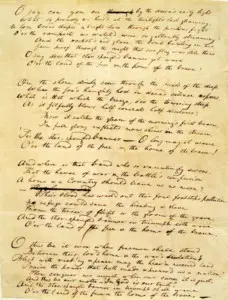
The British attack on Baltimore occurred only six weeks after the Battle of Stonington and was the beginning of a new massive offensive against the United States. The British, after finally defeating Napoleon, were now turning their attention to the war in America. A large British fleet of 19 ships sailed up the Potomac River and landed a military force of 4300 men in Virginia.
The British force marched north routing the American defenders and clearing a path into Washington D.C. President James Madison and the entire government fled the city. The burning of Washington took place that night. After several days the British turned their attention north to Baltimore, where they hoped to strike a powerful blow against the demoralized Americans.
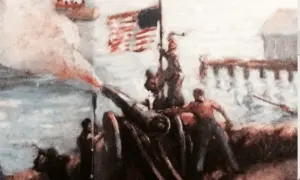
The Battle of Baltimore was a big U.S. victory and one of the turning points of the war. Key gave the poem to his brother-in-law, Joseph H. Nicholson, who saw that the words fit the popular melody by English composer John Stafford Smith. This was the official song of the Anacreontic Society, an 18th-century gentlemen’s club of amateur musicians in London. Nicholson set the words of the poem to the music and renamed it The Star-Spangled Banner. It soon became a big hit as a patriotic song.
The song, the Star-Spangled Banner, was recognized for official use by the United States Navy in 1889 and by President Woodrow Wilson in 1916. The song was made the National Anthem by a congressional resolution on March 3, 1931.
The flag was restored in 1914 and put on display in the Smithsonian Institution in Washington, DC. The Star Spangled Banner is now the most famous and revered symbol of our nation’s freedom.
There are many similarities between the Star Spangled Banner and the 16-Star Banner, both flags flew over American victories in the War of 1812 within weeks of each other, both flags were large. Stonington’s Sixteen Star Banner measures 12 feet by 18 feet and the Star Spangled Banner was exceptionally large at 30 feet by 42 feet. Lieutenant Colonel George Armistead, commander of Fort McHenry during the Battle of Baltimore, ordered the making of a flag so large that the British would have no difficulty in seeing it from a distance.
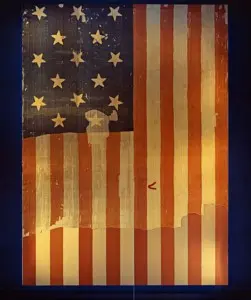
Although the Star Spangle Banner was originally 30 by 42 feet the flag today is only 30 by 34. This is because over the years pieces of the flag were snipped off as patriotic keepsakes. In addition, one of its stars was cut out and given away in the 1800s. It seems the American flag wasn’t deemed as important back then as it is today. The American flag didn’t really play a major role in the Revolutionary War and at the time it was created, it didn’t attract much attention. Its primary function was to identify ships and forts. Americans in the Revolutionary era turned to a variety of other symbols; the eagle, Lady Liberty, and George Washington to express their patriotism and define their national identity.
By giving the flag a starring role in one of the most celebrated victories of the war, Francis Scott Key’s song established a new prominence for the flag as an expression of national identity, unity, and pride. By giving it the name the Star-Spangled Banner Key transformed the official emblem into something familiar and evocative. The flag was no longer just an emblem of the nation; it became a representation of the country’s values and the ideals for which it stands.
This last August, on the 205th anniversary of the Battle of Stonington, the Sixteen Star Banner was put on display at the La Grua Center. Martha Geehan, textile curator for the Stonington Historical Society spoke about the flag. “This amazing flag was spun out of sheep’s wool by several women from the local Congregational Church. It was made for the 8th Company of the 30th Regiment of the Connecticut Militia and was flown during the battle of 1814 off Stonington Point. In 1949 the flag was given to conservationists, Mr. and Mrs. Fowler, the same couple who had conserved the Star Spangle Banner flag in 1914. They conserved it by stitching a linen backing onto the back of the flag, the same procedure they’d used to conserve the Star Spangled Banner.”
Today the Star Spangle Banner and its little sister the Sixteen Star Banner both represent the bravery of people who believed in fighting for their liberty. “When I first laid eyes on this flag in 2009 it was such an awe inspiring moment,” said Geehan. “It represented the men and women of this town that gave their souls, their strength, and their energy to preserving it.” The two flags are symbols of everything that is fine and special about the American spirit. Long may they both wave.
